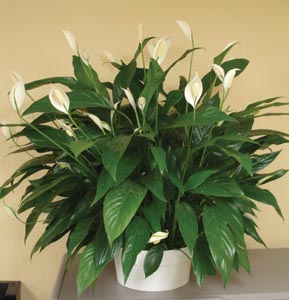12/15/2008
Speaking Up on Spaths
Chet Peckett

Spathiphyllum, or peace lily, is perhaps one of the most widely used indoor plants. The reason? The foliage is attractive and does well in lower-light interior environments. The white “spath” flower is also attractive and allows this plant to be categorized as a flowering pot plant. Overall, they’re popular because they perform well for the consumer and have a good perceived value.
Like any plant in production, they need the right environment to succeed. Costing and profitability obviously will depend on the individual operation and commitment to excellence.
Here are some tips for consistent and proper culture of this workhorse of a foliage plant.
Varieties. Fortunately in the last 10 years there has been aggressive breeding and hybridization of spathiphyllums, resulting in many new varieties. Some are better suited for small pot production, and others are bigger and tougher for larger pots. Thus far, most of the characteristics are more favorable for the grower, meaning they are more heat and cold tolerant, have faster growth, have a stronger growth character, are more prolific bloomers, and have better flower forms. All still have the white inflorescence. There are new varieties with variegated foliage that are doing well in production.
Propagation. Today, tissue culture is the main source or propagation. Since so many of the varieties are hybrids, seed is still used somewhat on some of the smaller-sized varieties.
Insects. Although often thought to be fairly pest free, there are some new insect concerns. Thrips can be a problem primarily in the spring and summer. Conserve, Talstar and Orthene offer good control. There is an eriophyte mite (a broad mite type) that is more prevalent today. Avid or any translaminar miticide is effective.
Diseases. As with any production plant, sanitation and prevention are vitally important. For cylindrocladium, Terraguard drenches offer good protection. For pythium, Subdue or Clearys is recommended and Aliette is a good treatment for foliar phytophthera.
Growth regulators. Gibberellic acid at a rate of 1 oz./gal. will force flowers. The response time will vary with the variety, temperature and day length. Ten or more weeks is an average.
Height control. Generally the variety will determine the finished height.
Grow times. Grow times depend on the variety, pot size and spec. Typically a 6-in. or 8-in. pot can take 10 or more months. As with any potted plant, the more space and time it’s given, the better the finished product.
Soil. Any well-drained synthetic blend is okay. The pH range should be 5.5 to 6.5.
Nutrition. Employ a well-balanced fertilizer program. Slow-release incorporated fertilizer does well. With supplemental liquid applications, typically spaths can easily be on constant feed at 200-plus ppm, providing the weather conditions are favorable. These plants are heavy users of magnesium and nitrogen, which can be supplemented as needed with foliar applications.
Chet Peckett is owner-operator of Peckett’s Inc., Apopka, Florida.